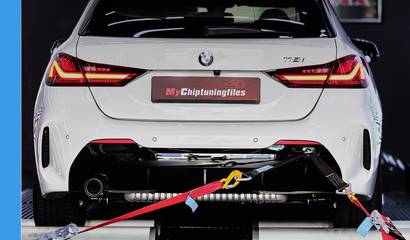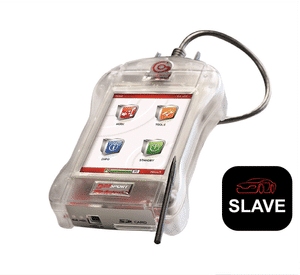Sunday 16 November

If you’ve been poking around the world of performance tuning for a little while, you’ve probably come across chip tuning files—those little bits of digital magic that can make your car run smoother, faster, or more efficiently. But once you actually decide you want one, things get a little tricky. Which file do you choose? Who do you trust? What if you pick the wrong one?
Truth is, choosing the right chip tuning file isn’t just a matter of clicking "download" and hoping for the best. Your car’s ECU is a delicate system. Feed it the wrong data, and you’re not getting extra power—you’re getting headaches.
So let’s break it all down. We’re going to walk through everything you need to know before choosing a tuning file: what they are, what they do, what to avoid, and how to make sure you're picking one that's right for your specific vehicle and driving goals.
No fluff. No sales pitch. Just a real, honest guide to help you get it right.
First off: What Exactly Is a Chip Tuning File?
A chip tuning file is basically a modified version of the software that controls your vehicle’s engine. It's tailored to tweak specific parameters inside your car’s ECU (Engine Control Unit), like:
- Boost pressure (for turbocharged engines)
- Fuel injection timing
- Air-fuel ratios
- Ignition timing
- Torque limits
- Throttle response
- RPM limits
By adjusting these, the tuning file can change how your car behaves. Want more torque at lower RPMs? Smoother throttle? Better fuel economy on the highway? There’s a file for that.
The magic happens when you flash this file onto your ECU using diagnostic tools or specialized tuning software. It’s like giving your car a new set of instructions—a better strategy for how to run.
Why the Right File Matters
Okay, so what’s the big deal? Why not just grab a tuning file online and go?
Well, because not all tuning files are created equal. The right file can make your car feel like a whole new machine. The wrong one can cause rough idling, poor fuel economy, check engine lights, or even engine damage.
Every car is a little different—even two of the same model from the same year might behave differently due to wear and tear, climate, fuel quality, or how they’ve been driven. That’s why choosing the right file means choosing one that matches not only your make and model, but also your goals and the current condition of your vehicle.
Let’s look at how to do that.
Step 1: Know Your Vehicle Inside and Out
Before you even start browsing tuning files, take stock of what you’re working with. The more details you know about your vehicle, the easier it will be to choose a compatible and safe file.
At minimum, you’ll want to know:
- Make, model, year
- Engine type (e.g., 2.0 TDI, 1.4 TSI)
- ECU make and version (Bosch EDC16, Siemens SID208, etc.)
- Transmission type (manual, auto, DSG, CVT)
- Fuel type (petrol, diesel, flex-fuel)
- Any existing modifications (intake, exhaust, turbo, intercooler, etc.)
This information helps narrow down the tuning file options. Some files are designed specifically for stock cars; others are built for vehicles with upgraded hardware. Using a performance tune on a stock car without the proper supporting mods can cause all kinds of issues.
Also, if you’re not sure about your ECU type or software version, most tuning tools or diagnostic scanners can read that info for you.
Step 2: Decide What You Want to Achieve
Not every tune is about power. In fact, one of the biggest mistakes people make is jumping straight into a performance tune without considering their real driving habits.
Ask yourself: what do you actually want from the tune?
- Better fuel economy? Then look for economy tuning files that optimize efficiency, especially for long-distance driving.
- More torque for towing or city driving? A torque-optimized tune might suit you better than an all-out power tune.
- Improved acceleration and throttle response? Look for a Stage 1 performance file with mild, safe gains.
- Track days or motorsport use? You’re in Stage 2 or Stage 3 territory, where things get more complex and hardware-specific.
Being clear about your goals helps tuning companies match you with the right file from the start.
Also Read: Is Chip Tuning Safe for Your Car? What You Should Know
Step 3: Choose the Right Tuning Stage
Tuning files are often labeled by “stage”—you’ve probably seen things like Stage 1, Stage 2, or even Stage 3+.
Here’s a rough breakdown:
- Stage 1: Mild performance improvements. No hardware changes needed. Designed for stock vehicles.
- Stage 2: Requires supporting mods (high-flow intake, exhaust, intercooler). More aggressive gains.
- Stage 3: Major upgrades required (big turbo, injectors, upgraded clutch, etc). Fully customized tuning.
If you’re not running any mods, Stage 1 is usually the safest place to start. It gives noticeable gains without compromising reliability.
Be very cautious about choosing a Stage 2 or Stage 3 file unless you’ve done the required upgrades. Using those on a stock car is asking for trouble.
Step 4: Work With a Trusted File Provider or Tuner
This is where things really matter. The quality of the file depends entirely on who’s writing it.
A good tuner knows your ECU platform, understands engine limits, and tests their files for stability and performance. A bad one might be selling mass-produced files that were never even tested on a real car.
Here’s what to look for in a tuner or tuning file provider:
- Experience with your specific car and ECU
- Custom file service (not just pre-made files)
- Dyno-tested results or before/after data
- Support in case of problems
- Safe and proven tuning practices (no overboosting, lean mixtures, etc.)
Ask for references or look for real-world reviews. And avoid the random eBay sellers offering $20 miracle tunes. That’s not tuning—that’s gambling.
Step 5: Think About Diagnostics and Data Logging
Even with a good tuning file, stuff can happen. That’s why it’s smart to choose a file provider who offers diagnostic support or can review logs if needed.
Some tuners offer remote tuning support, where you send them logs from your car and they fine-tune the file accordingly. This is the gold standard for a truly dialed-in tune.
You’ll need basic tools for this, like:
- An OBD diagnostic tool (like an ELM327 or KESS)
- Logging software (some ECUs support logging through apps or laptop software)
- Access to read/write your ECU (tools like KTAG, MPPS, etc.)
If you don’t have these tools or experience with ECU flashing, you can always work with a garage that does tuning installs for you. Many offer complete tuning packages, including file, flashing, and support.
Step 6: Make Sure It’s Safe for Your Setup
This one can’t be overstated. A tuning file should be safe for your engine, turbo, transmission, and drivetrain.
If your car has high mileage or has had mechanical issues, aggressive tuning might not be the best idea. You might be better off with a conservative file that improves throttle feel and fuel economy without pushing components too hard.
And if your car has aftermarket mods—especially for Stage 2 or above—make sure the tuning file accounts for them. You can’t run a big turbo on a stock fueling map and expect it to work well.
The best files are those tailored for your setup, whether it’s completely stock or fully built. Generic files might work in some cases, but custom is always safer.
Also Read: 5 Common Myths About ECU Tuning Debunked
Step 7: Understand What the File Actually Changes
Ask your tuner for a breakdown of what’s being changed in the file. Not all tunes are created equal, and transparency is key.
You’ll want to know if the file changes:
- Boost targets
- Timing advance
- Fuel injection mapping
- Rev limit or speed limiter
- DPF or EGR settings (on diesel vehicles)
- Torque limiters (important for automatic gearboxes)
Understanding these changes helps you make informed decisions—especially if you’re going to be driving the car daily. It also helps if you need to revert the file or troubleshoot later on.
Step 8: Think About Aftercare and Updates
Cars evolve. Software updates from the dealer, new mods, or engine wear can all affect how your tune behaves over time.
That’s why it’s smart to work with a tuner who offers aftercare—free revisions, retunes for new hardware, or even restoring your car to stock if needed.
Some tuning companies even keep a record of your original ECU file, so you can go back at any time. That’s a huge plus if you ever decide to sell the car or pass an emissions inspection.
Bonus: Don’t Forget About Legal Stuff
In some regions, tuning files that disable emissions systems like EGR valves or DPF filters are not road legal. If your file disables these, your car might fail inspections or emissions tests.
Make sure you understand the regulations in your area and choose a file accordingly. Some tuners offer “off-road use only” files that are meant for track cars or vehicles not driven on public roads.
And if you care about staying street legal, ask for a Stage 1 file that keeps emissions systems intact.
Ready to Grow? Start a Chiptuning Business with MyChiptuningfiles
Looking to start a chiptuning business and need a trusted file supplier to support your growth? MyChiptuningfiles provides professional, high-quality ECU tuning files tailored to your client’s vehicle specifications. Whether you're new to tuning or expanding your garage services, we make it simple to offer reliable performance upgrades.
Our experienced engineers use tools like WinOLS to create safe, effective remaps that improve power, torque, and fuel efficiency. Just upload the original ECU file through our platform—our team will analyze and return a ready-to-use tuning file with a fast turnaround time.
We support you beyond just delivering files. Our customer service team is available to answer your questions and help you develop confidence as you take on more tuning jobs. With consistent quality, fast delivery, and technical expertise, we help you build a solid reputation from day one.
Professionals worldwide rely on us for dependable tuning solutions. You can too. If you're serious about entering the tuning industry with the right tools and support, partner with MyChiptuningfiles.
Now is the perfect time to start a chiptuning business backed by experience and quality. Let’s take the first step together.
Final Thoughts
Choosing the right chip tuning file isn’t just about power. It’s about finding the right balance for your specific vehicle, your goals, and your driving habits.
The right file can make your car feel more responsive, more efficient, and just plain better to drive. But the wrong one? That’s when the problems start.
So take your time. Do your research. Talk to real tuners. Ask the right questions. And don’t be afraid to start slow—because when it comes to tuning, smarter always beats faster.
Once you’ve found the right file and got it flashed on your car, that first drive will tell you everything you need to know. If it feels smooth, confident, and fun, you’ll know you made the right choice.
Let me know if you want a downloadable version, some checklist templates, or tuning guides tailored to specific vehicles. Happy to help wherever you’re at in your tuning journey.
news.related_news
Chiptuning tools
Whether you own a car, truck or tractor: we have the best equipment and software for tuning your petrol and diesel engine. With our chiptuning tools it is possible to easily read out the original engine software of your vehicle and upload it to our website. And then it's up to us to provide you with high-quality and customized chip tuning files. Curious about our range of chiptuning tools? Check it out via the button below!









